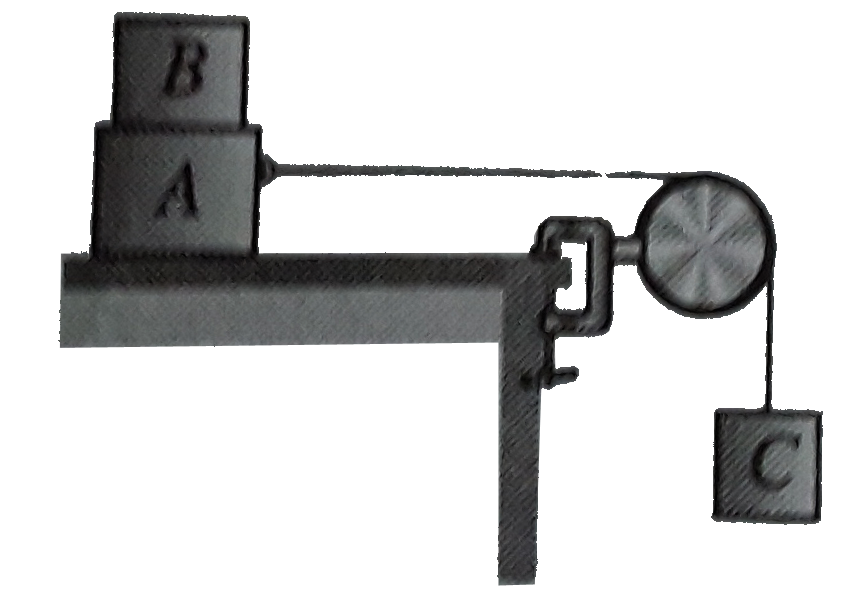Using the diagram from the previous example, assurme that m=2 kg, M= 10 kg, and the coefficient of kinetic friction between the small block and the tabletop is 0.5. What is the acceleration of the blocks ?
Once again, draw a free-body diagram for each object. Notice that the only difference between these diagrams and the ones in the previous example is the inclusion of friction, Ff that acrs on the block on the table.

As before, we have two equations that contain two unknowns (aandFT).
FT−Ff=ma(1)
Mg−FT=Ma(2)
We add the equations (thereby eliminating FT) and solve for a. Notice that, by definition, Ff=μFN and from the free body diagram for m, we see that FN=mg, so Ff=μmg :
Mg−Ff=ma+Ma
Mg−μmg=a(m+M)
M−μmm+Mg=a
Or, using our shorter method :

Substituting in the numberical values given for m, M, and μk, we find that a=34g ( or 7.5m/s2).
Topper's Solved these Questions
Similar Questions
If the mass of the block A = 10 kg and the coefficient of static and kinetic friction is 0.2, then the mass of block B to start the motion is

View Solution1 kg block collides with a horizontal massless spring of force constant 2N/m. The block compresses the spring by 4m. If the coefficient of kinetic friction between the block and the· surface is 0.25, what was the speed of the block at the instant of collision? (take g=10m/s2)

View Solution
Knowledge Check
Consider the situation as shown in the diagram.
The coefficient of friction between the block is 0.5. The acceleration of the lower block isA1m/s2B1.5m/s2C2m/s2D2.5m/s2A block of 5 kg is resting on a horizontal surface. The coefficient of kinetic friction between the block and the surface is 0.2. What is the acceleration with which the block will remove if a force of 9.8 N is applied to it ?
A2m/s2B3m/s2C1.5m/s2D2.5m/s2In the arrangement shown in figure coefficient of friction between 5kg block and incline plane is μ=0.5. Friction force acting on the 5kg block is
 A20NB15NC10ND5N
A20NB15NC10ND5N
A block of mass m = 2kg is accelerating by a force F = 20N applied on a smooth light pulley as shown in the figure. If the coefficient of kinetic friction between the block and the surface is μ=0.3, find its acceleration.

View SolutionBlock B of mass mB=0.5kg rests on block A, with mass mA=1.5kg which in turn is on a horizontal tabletop (as shown in figure) .The coefficient of kinetic friction between block A and the tabletop is μk=0.4 and the coefficient of static friction between block A and blockB is μs=0.6 A light string attached block A passes over a frictionless, massless pulley and block C is suspeneded from the other end of the string. What is the largest mass mc (in kg) that block C can have so that block A and B still slide together when the system is relaced from rest?

View SolutionBlock B of mass mB=0.5kg rests on block A, with mass mA=1.5kg which in turn is on a horizontal tabletop (as shown in figure) .The coefficient of kinetic friction between block A and the tabletop is μk=0.4 and the coefficient of static friction between block A and blockB is μs=0.6 A light string attached block A passes over a frictionless, massless pulley and block C is suspended from the other end of the string. What is the largest mass mc (in kg) that block C can have so that block A and B still slide together when the system is replaced from rest?

View SolutionA block of mass 2kg is acted upon by a force F= 200N at 37 as shown .The coefficient of static friction(us) is 0.6 and coefficient of kinetic friction (uk) between block and wall is 0.5 .The acceleration of the block will be
View SolutionBlock A has a mass of 2 kg and block B has a mass of 20 kg if the coefficient of kinetic friction between block B and the horizontal surface is 0.1, and B is accelerating towards the right with a=2m/s2 , then the mass of the block C will be -

View Solution
